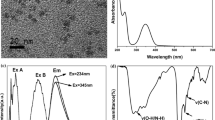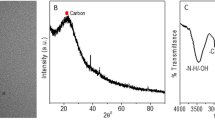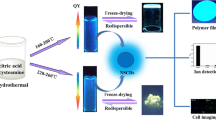Abstract
The present work is an attempt to investigate the heavy atom effect imparted by halide ions, especially iodide (I−) ions on the fluorescence behavior of carbon dots (CDs). Here two different types of CDs viz. nitrogen doped carbon dots (NCDs) from Citric Acid (CA) & Urea and Sulfur and nitrogen co-doped carbon dots (S,N-CDs) from CA & L-Cysteine were synthesized and the fluorescence of both CDs were quenched by heavy atom effect on adding potassium iodide (KI). The large difference in average lifetime was obtained in time-correlated single-photon counting (TCSPC) analysis suggests the dynamic quenching and heavy atom effect.

Graphical abstract




Similar content being viewed by others
References
Himaja AL, Karthik PS, Singh SP (2015) Carbon dots: The newest member of the carbon nanomaterials family. Chem Rec 15:595–615. https://doi.org/10.1002/tcr.201402090
Xiao L, Sun H (2018) Novel properties and applications of carbon nanodots. Nanoscale Horiz 3:565–597. https://doi.org/10.1039/C8NH00106E
Li H, Kang Z, Liu Y, Lee S-T (2012) Carbon nanodots: synthesis, properties and applications. J Mater Chem 22:24230. https://doi.org/10.1039/c2jm34690g
Wang Y, Hu A (2014) Carbon quantum dots: synthesis, properties and applications. J Mater Chem C 2:6921. https://doi.org/10.1039/C4TC00988F
Datta KKR, Qi G, Zboril R, Giannelis EP (2016) Yellow emitting carbon dots with superior colloidal, thermal, and photochemical stabilities. J Mater Chem C 4:9798–9803. https://doi.org/10.1039/C6TC03452G
Gu T, Zou W, Gong F, Xia J, Chen C, Chen X (2018) A specific nanoprobe for cysteine based on nitrogen-rich fluorescent quantum dots combined with Cu2+. Biosen Bioelectron 100:79–84. https://doi.org/10.1016/j.bios.2017.08.031
Park Y, Yoo J, Lim B, Kwon W, Rhee S-W (2016) Improving the functionality of carbon nanodots: doping and surface functionalization. J Mater Chem A 4:11582–11603. https://doi.org/10.1039/C6TA04813G
Liu G, Li S, Cheng M, Zhao L, Zhang B, Gao Y, Xu Y, Liu F, Lu G (2018) Facile synthesis of nitrogen and sulfur co-doped carbon dots for multiple sensing capacities: alkaline fluorescence enhancement effect, temperature sensing, and selective detection of Fe3 + ions. New J Chem 42:13147–13156. https://doi.org/10.1039/C8NJ02086H
Sun X, Lei Y (2017) Fluorescent carbon dots and their sensing applications. TrAC Trends Anal Chem 89:163–180. https://doi.org/10.1016/j.trac.2017.02.001
Sailaja Prasannakumaran Nair S, Kottam N, S G PK (2020) Green synthesized luminescent carbon nanodots for the sensing application of Fe3 + Ions. J Fluoresc 30:357–363. https://doi.org/10.1007/s10895-020-02505-2
Bharathi D, Krishna RH, Singh V, Kottam N, Siddlingeshwar B (2017) One pot synthesis of C-dots and study on its interaction with nano ZnO through fluorescence quenching. J Lumin 190:328–334. https://doi.org/10.1016/j.jlumin.2017.05.077
Berberan Santos NM (2000) External heavy-atom effect on fluorescence kinetics. PhysChemComm 3:18–23. https://doi.org/10.1039/B002307H
Mousa SA, Douglas P, Burrows HD, Fonseca SM (2013) Fluorescence quenching of protonated β-carbolines in water and microemulsions: evidence for heavy-atom and electron-transfer mechanisms. Photochem Photobiol Sci 12:1606–1614. https://doi.org/10.1039/C3PP50044F
Zhao Q, Huang C, Li F (2011) Phosphorescent heavy-metal complexes for bioimaging. Chem Soc Rev 40:2508–2524. https://doi.org/10.1039/C0CS00114G
Detty MR, Merkel PB (1990) Chalcogenapyrylium dyes as potential photochemotherapeutic agents. Solution studies of heavy atom effects on triplet yields, quantum efficiencies of singlet oxygen generation, rates of reaction with singlet oxygen, and emission quantum yields. J Am Chem Soc 112:3845–3855. https://doi.org/10.1021/ja00166a019
Green DC, Holden MA, Levenstein MA, Zhang S, Johnson BRG, Gala de Pablo J, Ward A, Botchway SW, Meldrum FC (2019) Controlling the fluorescence and room-temperature phosphorescence behaviour of carbon nanodots with inorganic crystalline nanocomposites. Nat Commun 10. https://doi.org/10.1038/s41467-018-08214-6
Knoblauch R, Bui B, Raza A, Geddes CD (2018) Heavy carbon nanodots: a new phosphorescent carbon nanostructure. Phys Chem Chem Phys 20:15518–15527. https://doi.org/10.1039/C8CP02675K
Nebu J, Anu KS, Anjali Devi JS, Aparna RS, Aswathy AO, Lekha GM, Sony G (2019) Pottasium triiodide enhanced turn-off sensing of tyrosine in carbon dot platform. Microchem J 146:12–19. https://doi.org/10.1016/j.microc.2018.12.021
Qu S, Wang X, Lu Q, Liu X, Wang L (2012) A biocompatible fluorescent ink based on water-soluble luminescent carbon nanodots. Angew Chem Int Ed 51:12215–12218. https://doi.org/10.1002/anie.201206791
Anjana RR, Anjali Devi JS, Jayasree M, Aparna RS, Aswathy B, Praveen GL, Lekha GM, Sony G (2018) S,N-doped carbon dots as a fluorescent probe for bilirubin. Microchim Acta 185. https://doi.org/10.1007/s00604-017-2574-8
van Dam B, Nie H, Ju B, Marino E, Paulusse JMJ, Schall P, Li M, Dohnalová K (2017) Excitation-dependent photoluminescence from single-carbon dots. Small 13:1702098. https://doi.org/10.1002/smll.201702098
Ding H, Yu S-B, Wei J-S, Xiong H-M (2016) Full-color light-emitting carbon dots with a surface-state-controlled luminescence mechanism. ACS Nano 10:484–491. https://doi.org/10.1021/acsnano.5b05406
Holá K, Sudolská M, Kalytchuk S, Nachtigallová D, Rogach AL, Otyepka M, Zbořil R (2017) Graphitic nitrogen triggers red fluorescence in carbon dots. ACS Nano 11:12402–12410. https://doi.org/10.1021/acsnano.7b06399
Edison TNJI, Atchudan R, Shim J-J, Kalimuthu S, Ahn B-C, Lee YR (2016) Turn-off fluorescence sensor for the detection of ferric ion in water using green synthesized N-doped carbon dots and its bio-imaging. J Photochem Photobiol B 158:235–242. https://doi.org/10.1016/j.jphotobiol.2016.03.010
Zhou W, Zhuang J, Li W, Hu C, Lei B, Liu Y (2017) Towards efficient dual-emissive carbon dots through sulfur and nitrogen co-doped. J Mater Chem C 5:8014–8021. https://doi.org/10.1039/C7TC01819C
Lakowicz JR (2013) Principles of fluorescence spectroscopy. Springer US, New York
Acknowledgements
The authors are deeply grateful to the Professor and Head, Department of Chemistry, University of Kerala for the generous support, laboratory, and instrumental facilities. The authors acknowledge DST-FIST, Government of India; CLIF, University of Kerala, Thiruvananthapuram, India; and STIC, CUSAT, Kochi, India for the sophisticated characterisation techniques provided for this research work. The authors also acknowledge SAIF, MGU, Kottayam, India for TCSPC analysis.
Author information
Authors and Affiliations
Corresponding author
Ethics declarations
Conflict of Interest
The author(s) declare that they have no competing financial interests.
Additional information
Publisher's Note
Springer Nature remains neutral with regard to jurisdictional claims in published maps and institutional affiliations.
Electronic Supplementary Material
ESM 1
(DOCX 780 KB)
Rights and permissions
About this article
Cite this article
Aswathy, A.O., Anju, S.M., Jayakrishna, J. et al. Investigation of Heavy Atom Effect on Fluorescence of Carbon Dots: NCDs and S,N-CDs. J Fluoresc 30, 1337–1344 (2020). https://doi.org/10.1007/s10895-020-02607-x
Received:
Accepted:
Published:
Issue Date:
DOI: https://doi.org/10.1007/s10895-020-02607-x




